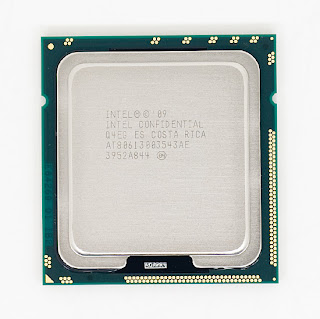
Lynnfield was introduced in 2009, but still couldn't dethrone Bloomfield
Intel Core i7 980X 3.33GHz 6 / 12 12 MB 3.60GHz 130W $999
Intel Core i7 975 3.33GHz 4 / 8 8 MB 3.60GHz 130W $999
Intel Core i7 960 3.20GHz 4 / 8 8 MB 3.46GHz 130W $562
Intel Core i7 930 2.80GHz 4 / 8 8 MB 3.06GHz 130W $284
Intel Core i7 870 2.93GHz 4 / 8 8 MB 3.60GHz 95W $562
Intel Core i7 860 2.80GHz 4 / 8 8 MB 3.46GHz 95W $284
Intel Core i5 750 2.66GHz 4 / 4 8 MB 3.20GHz 95W $196
Intel Core i5 670 3.46GHz 2 / 4 4 MB 3.73GHz 73W $284
Intel Core i5 661 3.33GHz 2 / 4 4 MB 3.60GHz 87W $196
Intel Core i5 660 3.33GHz 2 / 4 4 MB 3.60GHz 73W $196
Intel Core i5 650 3.20GHz 2 / 4 4 MB 3.46GHz 73W $176
Intel Core i3 540 3.06GHz 2 / 4 4 MB N/A 73W $133
Intel Core i3 530 2.93GHz 2 / 4 4 MB N/A 73W $113
Intel Pentium G9650 2.80GHz 2 / 2 3 MB N/A 73W $87
The Entire 2010 Nehalem/Westmere lineup
In fact, that’s exactly what I did for today’s review. This is Intel’s DX58SO motherboard I used in my original Core i7 review in November 2008:
It’s the same exact board, but updated to the 5020 BIOS that’s currently available on Intel’s site. Intel was sneaky and actually enabled Gulftown support in its motherboards a few weeks ago.
And here we have the result:
Intel’s Core i7 980X, running at 3.33GHz with 6 cores, 12 threads and a massive 12MB L3 cache all running on a motherboard that shipped a year and a half ago.
The old board works mostly fine with the 980X but with some odd bugs and quirks that I ran into. I found that my older DDR3-1066 memory wouldn't overclock to 1333MHz with Gulftown, although it did just fine with Bloomfield for some reason.
It’s not just Intel enabling support either. All motherboard manufacturers either have or are expected to have BIOSes with Gulftown support by the time this chip ships in the coming weeks. ASRock sent over its X58 Extreme, which worked perfectly with the new chip:
It’s Extreme
The coolest part of Gulftown is that by building it on Intel’s 32nm process it’s actually smaller than both Bloomfield and Lynnfield, despite having 50% more cores and L3 cache:
At 1.17 billion transistors, it’s a beefy chip but the monolithic die only measures 240mm^2. It’s even smaller than an AMD Phenom II X4. Not only does it have a smaller die than all quad-core Nehalem processors, but it also has the same TDP.
The 130W chip runs at 3.33GHz, but because of the high TDP it can only turbo up to 3.46GHz with more than two cores active. If only one or two cores are active, the chip can turbo up to 3.60GHz. With up to 6 cores running at 3.46GHz, Gulftown is not only the fastest CPU in Intel’s lineup, it’s also the fastest quad-core Intel makes. Only the Core i5 670 can run at a higher frequency with a single core active (3.73GHz vs 3.60GHz).
The downside to all of this is the price tag. The Core i7 980X is an Extreme Edition processor, meaning it’s introduced at the $999 price point. And currently it’s the only way to get 6-cores in a Core i7. Currently Intel doesn't have any plans to introduce 4-core versions of Gulftown on the desktop, although we will see some 32nm quad-core Xeons later this year.
Bloomfield (left) vs. Gulftown (right)
This isn’t the first time that the $999 price tag comes with some exclusive features. The first Pentium 4 Extreme Edition was the very first to wear the EE brand. While all regular Pentium 4s at the time had a 512KB L2, the Pentium 4 Extreme Edition added a 2MB L3 cache - a feature that never trickled down to the mainstream P4s.
Since then, most Extreme Edition parts have just been higher clocked CPUs. Despite that, they do sell well enough for Intel to continue the practice. Given that this time around, the Core i7 980X will not only give you clock speed but more cores and cache, Intel will probably end up selling more of these than they ever have.





